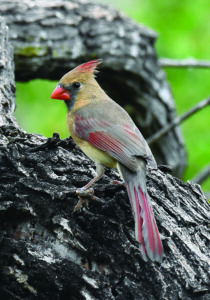(Editor’s note: Suzette Stitely is a member of the Talbot Bird Club and travels extensively for birdwatching.)

The Northern Cardinal female features a more subdued brown-gray color overall with red on the wings and tail. (Photo by Suzette Stitely)
When you gaze out into your barren backyard this winter, one bird stands out amongst all the rest — the Northern cardinal.
The Northern Cardinal is a large bird with a jaunty crest, long tail and a red bill.
The species is sexually dichromatic with the male being entirely a stunning red color with a black face and the female is a more subdued brown-gray overall with red on the wings and tail.
Their red plumage color results from carotenoid pigments obtained from the diet during molt. Studies have found that redder males (and females with more red in underwing) have larger territories with more food choices and have greater reproductive success.
A larger black face mask has been linked with aggressive behavior in some populations.
So the next time a male Northern cardinal wakes you up repeatedly in the spring by pecking loudly on your window, notice how red his pigment is and how large and black his face mask.
You’ll frequently see Northern cardinals together in winter as they are one of our first nesters in the spring.
Courtship displays begin in February on the Mid-Shore and nest building begins in March.
They prefer to place their nest in thick tangles of vines and it’s built by the female bird.
One to five eggs are usually laid, but sadly Northern Cardinals suffer from very high rates of nest failure.
Mostly this is due to predation by snakes and by nest parasitism by Brown-headed cowbirds which will actively remove cardinal eggs and lay their own in the nest.
Cardinal nestlings are fed mostly insects and fledge at around ten days.
While banding studies have found long-lived birds (a 15-year old female and a 13-year-old male), most Northern cardinals are fortunate if they live three years.
So as our cold winter days turn longer and warmer, listen for both male and female
Northern cardinals singing their sweet song of “what cheer, what cheer.”
It’ll remind you that spring is just around the corner.
Learn more about birds, including the Northern cardinal, by joining the Talbot Bird Club.
The Talbot Bird Club offers local birding trips weekly and welcomes anyone who has an interest in birds, whether a novice or experienced ornithologist, and whether you enjoy watching birds at your feeder or traveling throughout the world.
Our members learn from one another and are willing to share their knowledge.
The Talbot Bird Club is part of the Maryland Ornithological Society and also has a Facebook page.



